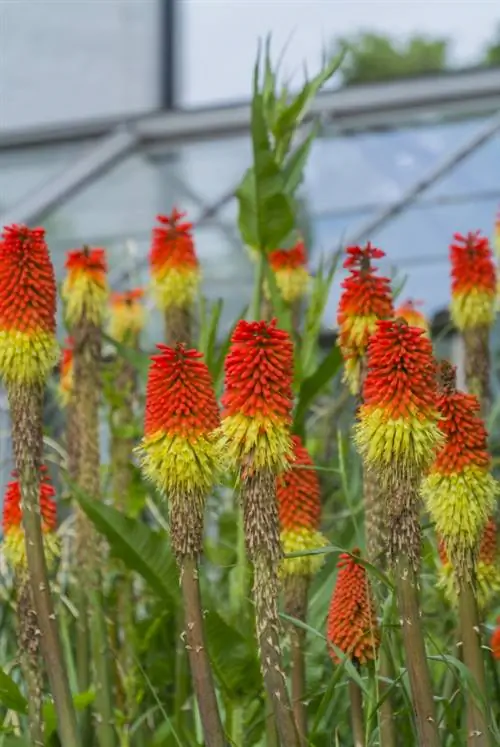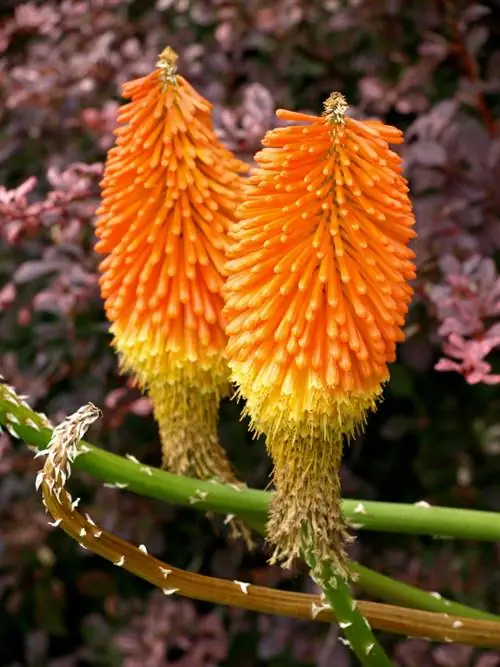- Author admin [email protected].
- Public 2023-12-25 17:45.
- Last modified 2025-01-23 11:22.
With its flower candles, the torch lily lights a glowing bonfire all summer long. Don't puzzle over the maintenance effort any longer, because you'll get all the answers about skillful cultivation here.

How to care for a torch lily in the garden?
To successfully cultivate the torch lily, choose a full sun to sunny, warm location with wind-protected, humus, loamy-sandy, well-drained soil. Water and fertilize regularly during the growing phase, remove wilted flowers and take frost protection measures in winter.
Care tips
It is no coincidence that the torch lily is a welcome guest in the green realm for hobby gardeners, because care is limited to these measures:
- Don't skimp on irrigation water during the summer
- Do not water the flowers, but water directly to the roots
- Fertilize repeatedly from May to August with compost (€10.00 on Amazon) and horn shavings
- Administer liquid fertilizer in the bucket every 14 days
Cut off wilted flower candles regularly. The leaves remain on the plant until spring and are then cut off close to the ground. A layer of pine fronds, leaves or straw protects torch lilies from winter damage. If temperatures are low below zero and there is no snow, water torch lilies on a frost-free day.
Which location is suitable?
Since the colorful ornamental perennial comes from the sun-drenched regions of South Africa, the location chosen should be as close as possible to the conditions there. The torch lily thrives in these locations:
- Full sun to sunny location
- Warm and protected from the wind
- Humose soil, loamy-sandy and well-drained
- Preferably with a slight lime content
read more
When is flowering time?
Depending on the variety chosen, the flowering period begins in June and continues into October in summer weather. So that you can enjoy the rocket flowers over the entire period, the varieties are combined accordingly. For example, combine early-blooming “Grandiflora” and “Royal Standard” with late-blooming “Bernocks Triumph” and “Abendstern.”
In addition, you can extend the flowering period by shortening withered stems to 20 centimeters after the first bloom. On the other hand, it is a misconception that abundant fertilizer has a beneficial effect on flowering. An overdose of fertilizer actually causes increased leaf growth to the detriment of the flowering period.read more
Cut torch lily correctly
Apart from the regular cutting of wilted flowers, the torch lily doesn't get acquainted with secateurs during the year. If you aim to harvest the seeds, do not cut off withered flowers at first. Leave the wintergreen leaves on the plant until spring and then cut them off close to the ground.
Cut a torch lily during the transition from bud to flower and you will get a long-lasting vase decoration.read more
Wintering
Due to its South African origins, the torch lily is considered to be partially hardy. It's less the frosty temperatures than the constant winter wetness that causes problems for a rocket flower. Therefore, take these precautions before the first frost:
- Cut off the wilted flower stems and leave the foliage
- Use sisal or raffia ribbon to tie the leaves into a loose bun
- Finally, cover the bed with straw, needles or leaves
- Only water a little on frost-free days when there is clear frost and do not fertilize
In explicitly rough locations, dig up the roots to place them in a pot with potting soil. In a bright, frost-free room, the torch lily gets through the cold season well protected and can be planted out again in May. During this time, do not let the flower dry out completely and stop fertilizing.
Is torch lily poisonous?
Good news for young parents and responsible grandparents: the torch lily is not poisonous. It can therefore be cultivated safely within the reach of children. The ornamental perennial also poses no danger to pets.read more
Torch lily not blooming
If a torch lily refuses to bloom, this deficiency results from various causes. Although it is a perennial, the flower initially exhibits the behavior of a biennial plant. It is not uncommon for torch lilies to only bloom for the first time in the second or third year after planting. If the young plant comes from sowing seeds, it can take up to 5 years for the first flower to appear. If an established rocket flower does not bloom, these triggers should be considered:
- Waterlogging with resulting root rot
- Nutrient deficiency due to insufficient fertilizer application
- Winter damage due to insufficient protective measures
- Premature pruning in autumn instead of spring
read more
The seeds of the torch lily
Aim to sow seeds, do not cut off withered flower heads. Instead, the capsule fruits now ripen in order to harvest the seeds inside. Since these are cold germinators, put the seeds in a plastic bag with moist sand. When stored in the vegetable compartment of the refrigerator, the seeds undergo a six-week stratification, without which germination will not occur. This is how the sowing continues:
- Fill small cultivation pots with peat sand, coconut humm or commercial seed soil
- Place 2-3 seeds each on the moistened substrate and sieve thinly
- Keep constantly moist in a partially shaded, warm window seat
Within 4 weeks, the delicate cotyledons break through the seed coat. If at least 1 pair of true leaves has developed above the cotyledons, the young torch lilies are pricked out. Until the planting season begins in mid-May, care for your young plants in a bright, warm location without the blazing midday sun.read more
Is the torch lily hardy?
The majority of torch lily species and varieties are not completely hardy. Nevertheless, you can spend the cold season in the garden if you take the following precautions:
- Don't cut the leaves in autumn
- Instead, tie the leaves together, leaving the heart largely exposed
- Cover with leaves, straw, pine fronds or reed mats
Torch lilies in pots are better placed in a bright, frost-free winter quarters.read more
The most beautiful varieties
- Fire candle: pompous flower torch in orange-red with a long flowering period from July to October
- Ice Queen: royal magnificent variety with creamy white flowers and a majestic height of 120 centimeters
- Saffron bird: the delicate variety impresses with iridescent flower candles in salmon pink and cream
- Vanilla: once the creamy yellow flowers have exuded their charm, the wintergreen foliage adorns the garden
- Little Maid: the yellow-flowering torch lily is recommended for pot cultivation with a graceful 50 cm height
- Royal Standard: two-tone noble variety in red and yellow with a robust constitution and early flowering
- Luna: impressive rocket flower with light yellow flowers and a height of up to 120 centimeters
- Alcazar: popular pot flower thanks to its fiery red flowers from July to September, at a height of 40-90 centimeters
- Green Jade: slim silhouette and subtle greenish white flowers characterize the beauty
- St. Gall: an extremely robust torch lily with orange flowers from August to October






